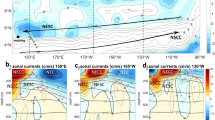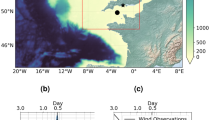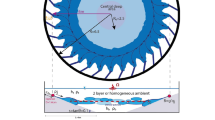Abstract
IN recent years large, high-speed, eastward flows beneath the surface along the equator have been discovered and/or rediscovered1. The structure of the Cromwell Current in the central and eastern Pacific has been described in some detail2. The current is symmetrical about the equator, has a transport as great as 40 × 106 m3/ sec and has a maximum speed in the thermocline of about three knots. The current appears to be steady and to be in geostrophic balance to within a half a degree of the equator. The distributions of oxygen, salinity and other properties indicate upwelling of water along the equator and strong vertical mixing. The observations in the Atlantic Ocean indicate that the current structure there is remarkably similar3.
This is a preview of subscription content, access via your institution
Access options
Subscribe to this journal
Receive 51 print issues and online access
$199.00 per year
only $3.90 per issue
Buy this article
- Purchase on Springer Link
- Instant access to full article PDF
Prices may be subject to local taxes which are calculated during checkout
Similar content being viewed by others
References
Montgomery, R. B., J. Oceanogr. Soc. Japan, twentieth anniv. vol. (in the press).
Knauss, J. A., Deep-Sea Res., 6, 265 (1960).
Metcalf, J. L., Voorhis, A. D., and Stalcup, M. C., J. Geophys. Res., 67, 2499 (1962).
Author information
Authors and Affiliations
Rights and permissions
About this article
Cite this article
KNAUSS, J., TAFT, B. Measurements of Currents along the Equator in the Indian Ocean. Nature 198, 376–377 (1963). https://doi.org/10.1038/198376a0
Issue Date:
DOI: https://doi.org/10.1038/198376a0
Comments
By submitting a comment you agree to abide by our Terms and Community Guidelines. If you find something abusive or that does not comply with our terms or guidelines please flag it as inappropriate.



